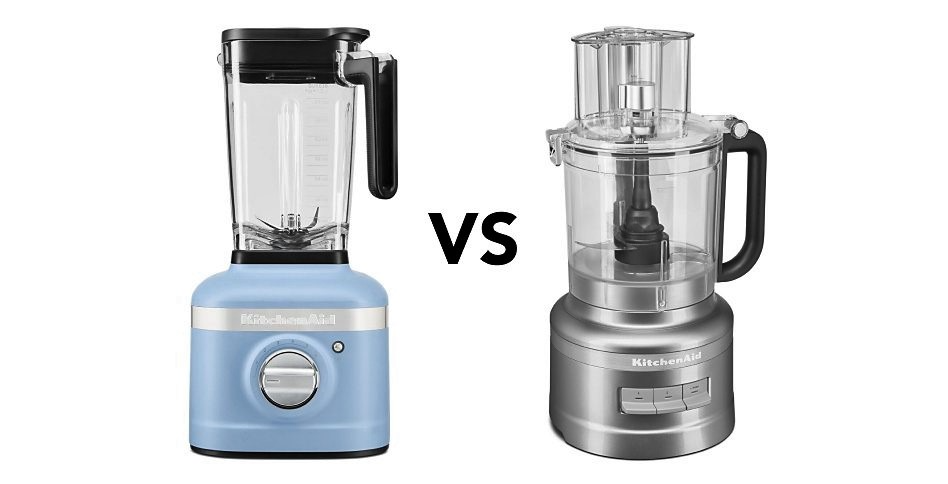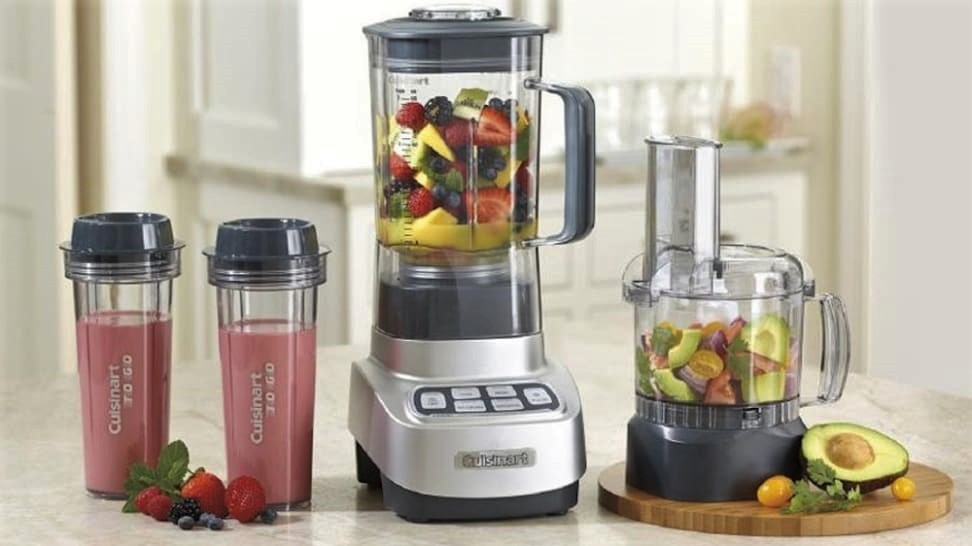Last updated on April 7th, 2025 at 08:00 pm
Can blenders be used as a food processor, even though they were initially designed to liquefy and combine dry ingredients? A resounding yes to this question since they are often used in the same capacities as food processors. Because food processors are designed to handle more significant pieces of food, you’ll need to break down the meal before blending it in a blender.
There are a plethora of helpful kitchen appliances, but these three stand out. Because of their flexibility and utility, they have become a popular choice for food preparation. However, it’s a question we get asked a lot: Can blenders be used as a food processor?
Blenders and food processors are expensive, but it doesn’t make sense to have both of them in your kitchen when one can perform the job of the other. Can blender be used as a food processor, though? To discover out, let’s get started.
Are Blenders And Food Processors The Same Thing?
Contrary to popular belief, blenders are not the same as food processors. In comparison, their swords are not as sharp, and they are incapable of piercing hard materials. For blending and pureeing food, blenders are the finest tool. But they can be blenders used as a food processor.
Blenders use processors, which are the primary tools. They have a lot of power and are intended to make sauces, smoothies, frozen drinks, and liquefied beverages with ease.
In contrast to blenders, food processors have less powerful motors, but their blades are sharper, allowing them to cut through more challenging materials. Food processors are pretty flexible, and they can easily prepare vast portions of food. Fast-cutting blades will enable them to sift through nuts and seeds swiftly.
Food processors, on the other hand, are more suited to pulverizing materials than most blenders.

What Is The Operation Of Blenders And Food Processors?
In the last several years, the ordinary blender has evolved from being able to just handle liquids to now being able to take fruits, vegetables, ice, seeds, and nuts as well. For the most part, this is due to blades that are complex and sharper and many more of them and solid engines, and the use of containers that aid in creating a vortex to bring food towards them.
As a result, instead of manually pounding a blender, you can just choose software and let it do the work for you instead. Additionally, some blenders are equipped with a tamper for pushing frozen lumps into the blades, whereas others have distinct edges for milling and grinding seeds and coffee beans.
Either one-two bowl are attached to a food processor with a blade or discs that rotate to slicing and chop. When it comes to kitchen instruments, there is a considerable difference in the number of options available, including the ability to chop chips, whip with a whipping disk or attachments, knead the dough, or even tumble potato to remove the skins. Some versions include built-in scales that allow you to measure out and mix in the same bowl, making it easier to produce cake batter or cookie dough in less time.
In the last several years, the ordinary blender has evolved from being able to just handle liquids to now being able to take fruits, vegetables, ice, seeds, and nuts as well. For the most part, this is due to blades that are complex and sharper and many more of them and solid engines, and the use of containers that aid in creating a vortex to bring food towards them.
As a result, instead of manually pounding a blender, you can just choose software and let it do the work for you instead. Additionally, some blenders are equipped with a tamper for pushing frozen lumps into the blades, whereas others have distinct edges for milling and grinding seeds and coffee beans.
Either one-two bowl are attached to a food processor with a blade or discs that rotate to slicing and chop. When it comes to kitchen instruments, there is a considerable difference in the number of options available, including the ability to chop chips, whip with a whipping disk or attachments, knead the dough, or even tumble potato to remove the skins. Some versions include built-in scales that allow you to measure out and mix in the same bowl, making it easier to produce cake batter or cookie dough in less time.
If you have a blender, you can be used as a food processor, but you’ll need to adjust specific settings. Food processors offer a wide range of applications in the kitchen, from slicing onions to producing breadcrumbs. Although blenders have many of the same purposes as juicers, they are also a helpful kitchen device for making juices and smoothies.
- Changing the speed settings and slowing the blending process is necessary initially.
- It takes less than a minute for a blender to break down a piece of food into liquid form. This approach is much faster than using a stick blender. A few parameters, however, will have to be altered from pureed or liquid to normal.
- A mixer is used to make drinks, purees, or liquids, while a food processor breaks food into smaller pieces. For thicker, more like a food processor-like texture, do not add any liquids.
Using a blender is not an option if you want to chop or grate your food. Use a decent old-fashioned knife if you’re going to chop and slice vegetables or fruit for your salads!
Cutting and slicing are two of the most challenging tasks for food processors, and they can’t be done using a blender. Instead of going for the food processor, turn the knife over and in your fingers if you want finely chopped vegetables and fruits for vinaigrette or salsa.
- Slow Down The Blending
While food processors may cut up the meal or drink, blenders may not effectively mix your food or beverage. A food processor isn’t necessary, but you may simulate its strength by letting your blender pulse often enough not to over-blend — this will help give your dish a more distinct texture and taste!
- Reduce The Amount Of Water You Use
Start with less liquid and blend until smooth, just as you would with a food processor when making a smoothie. To avoid light or soup-like meals, you might start with less liquid and gradually add more if required.
- Reduce The Ingredient Quantity
As an alternative, if you don’t have a stick blender and are still making smoothies in your blender, be creative! For cold smoothies, you may add extra ice or frozen fruit. Using leftover grilled pork as a flavor enhancer in hot liquids like soup is a great idea.
Scraps of dinner plates may be used to chop up veggies or meats before they are used in a blended meal if you have an onion cutting board and any leftover sauces to add.
It is possible to determine if your meal is over if the food just at the top of your blender pitcher is so thick that you can see through it. Since this is the case, just one or two more components per item should be added while making meals in blenders; otherwise, things start becoming odd and disgusting!
- Make Use Of The Proper Presets
You need to select the proper speed for your work while using a mixer rather than a food processor. Blenders come at a variety of rates, ranging from three to six. For certain things, like ice cubes, you may need to try various settings until you get acclimated to how lower or higher the blades will go before they aren’t too difficult to work with.
Blending may be done at one of two speeds: slow and fast. These two tools may be used in various ways, from smoothies to cutting and puréeing food. The easiest way to learn how to use a blender as a food processor is to not put all of your combinations at once so that if anything goes wrong, there would still be plenty for another attempt!
- You Shouldn’t Use the Liquefy or Purée Settings.
While food processors and blenders may both be found in the kitchen, each serves a specific function. The blender is ideal for producing puréed soups or liquid drinks, while the processor is as good at chopping things. If you use one to purée soup or coagulate ice cubes, your results won’t be as smooth as they would be with an old-fashioned stick-style blender due to its design.
Is A Blender Suitable For Processing Food?
However, although both are meant to prepare or chop more tough items, they operate in quite different ways. To avoid having an unmanageable thick soup that adheres to the spoon when mixed, you may produce several thicker soups using a mixer instead of utilizing only one device for all your requirements.
It’s best not to use a blender to make ice cream since they don’t perform well at making solid desserts out of anything other than liquids. Instead of wasting time learning how can blenders be used as food processors, you may create a stress-free cooking environment for yourself.
You shouldn’t have to struggle to find out how this device works and then play with it till it malfunctions. In the kitchen, food processors may be handy and can be used in various ways, but if you can’t afford one. To save time and money, you may always use blades or a vegetable cutter.

In A Food Processor Or Blender, What Are You Searching For?
- Capacity: Blender time is an excellent opportunity to use a small bowl to incorporate and combine the ingredients. Mixing modest amounts of anything in a large basin is impossible. Because of this, you’ll need a variety of bowl jar blenders.
- Control: It depends on your preference. Do you prefer knobs and buttons, or do you choose the touch screen? In this post, we’ll go through a variety of control options. There are no more than two buttons on the simple control scheme. If you want a wide range of options, this blender is for you.
- Cleaning: Sharp blades on food manufacturers and blenders provide a cleaning concern. Different parts open & clean is safe cleaning solution.
What Blenders Are Good Alternatives To Food Processors?
Can blenders be indeed used as a food processor? However, this isn’t true of all blenders! Meat slicers may be replaced with powerful blenders with accelerators as powerful as food processors. If you are contemplating purchasing a blender that can also function as a food processor, I have compiled this list to assist you in your decision.
- Immersion Blender Control Grip for Breville BSB510XL
- The Health master Elite JLA-8WAL Blender is the best in the business
- Auto-IQ Base for Juices, smoothies, and shakes Ninja BL480D Nutri 1000 Watt
- It has a powerful 500-watt stainless-steel stick blender with variable-speed control, as well as a 6-cup food processor.
These high-tech blenders are capable of blending, chopping, and grinding a wide variety of culinary items. Because their blades are more potent and sharper than conventional blenders, these machines can chop through hard fruits and other things. These models have a lot of positive feedback from customers, and they’re also highly rated.